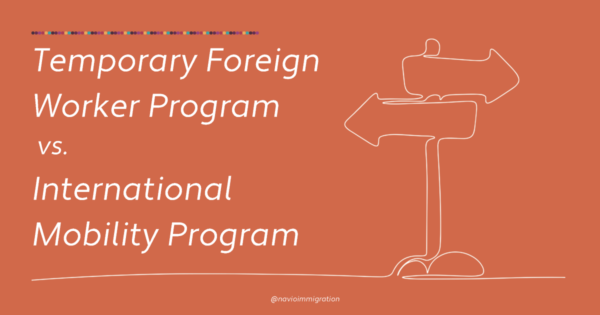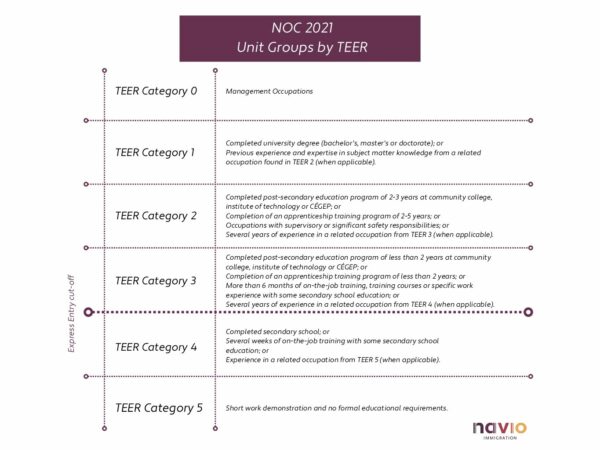6 Essential Canadian Immigration FACTS EVERY EMPLOYER must KNOW to address Labour & Skills Shortages.
Canada’s aging population and declining birth rates are a serious threat to the country’s labour force. People immigrating to Canada contribute significantly to filling labour and skills shortages, thus accounting for the majority of Canada’s labour force growth. Without a doubt, Canadian employers must consider implementing immigration strategies into their workforce planning strategies to avoid labour shortages, safeguard operational continuity and support revenue-generating activities.
Here are 6 essential facts employers need to know about Canadian immigration:
1. High and Low-Skilled Occupations
Recruiting, hiring and retaining foreign workers begins with understanding the National Occupational Classification (NOC) 2021 system. The NOC categorizes occupations by skill level.
Occupations are grouped by TEER level:
- Training,
- Education,
- Experience,
- and Responsibilities.
TEER levels 0, 1, 2, and 3 are considered highly skilled. The levels 4 and 5 are considered entry-level or semi-skilled.
Work permit and permanent residency eligibility hinges on the skill level of the job you’re offering. Your obligations as an employer also differ depending on whether you’re hiring a highly skilled worker, or an entry level and semi-skilled worker.
Hiring foreign workers and supporting their applications for permanent residency starts by determining the skill level of the job and then identifying the programs available based on the NOC code and skill level.
2. Median Wage
Job Bank posts median wages for every occupation in the NOC, based on the location of employment. In most cases, employers must offer foreign workers the median wage rate as posted on Job Bank, at minimum. If you hire a foreign worker through the Temporary Foreign Worker Program (TFWP), the wage you offer must also be within the range you offered to existing employees in the same occupation with similar qualifications.
You must confirm the wage requirements for the position in which you’re hiring/employing the worker to ensure you meet program requirements and uphold compliance obligations.
3. Work permits
Almost everyone who is not a Canadian citizen or permanent resident needs a work permit authorizing them to seek employment in Canada. Some individuals can work without a work permit (for example, some international students). Make sure you confirm that your employee is legally authorized to work. Keep in mind that some work permits are “open” which means the individual can work in any occupation for any employer, while other work permits are “closed”, meaning the individual can only work for the employer in the location and occupation specified on the permit.
Work permits carry additional conditions, which you can find at the bottom of the work permit in the remarks section. Check these carefully to verify the foreign worker is authorized to work in the location and occupation you’ve offered them.
Here are 2 examples of important remarks you might find on a work permit:
- Co-op work permit: international students who are studying a program that includes a co-op are issued a work permit. This permit allows them to only complete the co-op work placement. We’ve seen many situations where an international student then works after completing their studies, under the false understanding that the co-op work permit authorizes them to do so. The co-op work permit specifies that the permit only authorizes work related to the completion of the co-op placement.
- Jobs in which public health must be protected. A foreign worker cannot work in healthcare, primary or secondary school, in-home care, or child-care settings without first completing an immigration medical exam. The remarks will specify occupations in which the foreign worker is not authorized to work. The absence of a comment doesn’t necessarily mean the foreign worker is permitted to work in these settings. It may have accidentally been omitted. If hiring in these positions, confirm with the foreign employee that they’ve completed a medical exam.
4. Temporary Foreign Worker Program (TFWP) v.s. International Mobility Program (IMP)

IRCC issues all work permits either under the TFWP or IMP.
Work permits issued under the TFWP require a Labour Market Impact Assessment (LMIA). You must apply for an LMIA before a foreign worker can receive a work permit. You may be exempt from requiring an LMIA in certain situations, which we’ll discuss more further on. If you’re applying for an LMIA, you must advertise the position to recruit Canadian citizens and permanent residents, first. Your recruitment efforts must meet strict criteria, including location and duration of advertising, content of the job ad itself. You must then prove you’re unable to recruit a qualified and available Canadian citizen or permanent resident. Finally, you must demonstrate to Employment and Social Development Canada (ESDC) that hiring foreign workers will have a neutral or positive impact on the Canadian labour market.
On the other hand, employers can hire foreign workers through programs managed under the IMP. These work permits are issued in cases that advance the goals outlined in the Immigration and Refugee Protection Act, like generating significant economic, social, and cultural benefits and increasing French-speaking populations across Canada. An LMIA is not required in these cases. Instead, you must submit the job offer to IRCC through the Employer Portal before the foreign worker applies for a work permit.
5. Employer Compliance
You have obligations to uphold if you hire foreign workers on “closed” work permits (i.e. work permits that name your company in the employer field). This is true of all work permits issued under the TFWP and all closed work permits issued under the IMP.
Essentially, you must ensure the working conditions and wages are equal to, or not less favourable than, what the foreign worker was offered. You must also maintain records (i.e. payroll) for at least 6 years as you may be subject to a compliance audit. You may be audited at random or because of a complaint. Steep penalties are in place for employers who don’t uphold their obligations. These include fines and being featured on the ineligible employer list.
6. Supporting an Employee’s Permanent Residence
An overwhelming majority of foreign workers aim to become permanent residents. As an employer, you can implement strategies to proactively support your employees in pursuit of their immigration goals. This support can lead to many benefits – improved employee retention, workforce planning efforts, operational continuity, and employee satisfaction, to name a few.
Our guide, What’s in Store for 2024, is a crash course in applying for permanent residence. It provides valuable insights and knowledge for employers and foreign workers. The nature of the job offer, and your commitment, vary by program. Most commonly, employers can support an employee with:
- a valid job offer in the Express Entry system,
- or a job offer to a provincial nominee program.
A job offer to support a foreign worker’s application in the Express Entry system must be full-time for a year after the individual becomes a permanent resident. You must generally have an LMIA to support this offer unless the employee has been employed for a year on a closed work permit and the work permit remains valid.
The conditions of your job offer to support a foreign worker’s application in a provincial nominee program will vary based on the province and category of the application. For example, the British Columbia Provincial Nominee Program (BC PNP) Skilled Worker program requires a full-time, indeterminate job offer.
TL;DR
Investing in immigration planning and strategically integrating it into your workforce has significant benefits. Increased employee satisfaction, lower employee churn rate, recruitment cost savings, improved operational efficiency and business continuity, higher customer satisfaction rates, and, ultimately, increased revenue.
Written on January 17, 2024, by Brooke Finlay

